The headline could also have been "Recovery means digging | off-road recovery | pick & shovel | sand, mud & snow" or simply "recovery equipment". Either way, especially for overlanders like us, as well as offroaders of all kinds, recovery equipment is an important part of the equipment. If you want to move your van, transporter, expedition vehicle or travel vehicle off the beaten track, you should take a closer look at the subject of recovery. Drivers of a Land Rover Defender, Jeep or Land Cruiser anyway. There one calls this species-fair attitude. After all, you don't just want to get into the terrain, you also want to get out again.
Passion Recovery & Digging
Offroad, a passion that creates suffering? - There are said to be people who like to drive their vehicle so far into the dirt that it is clear from the outset that they are digging here. As a rule, we do not belong to these people. Exceptions are only appropriate trainings. But we love it all the more wild & free on lonely beaches, at the mountain lake or on a cliff to stand.
This brings with it the risk that you might have to tackle something. Something like this doesn't happen every day. But you can be sure that you then have to and may get along without ADAC & Co. Probably there is no radio network anyway. It's just a network and therefore full of holes. Otherwise it would be called carpet.
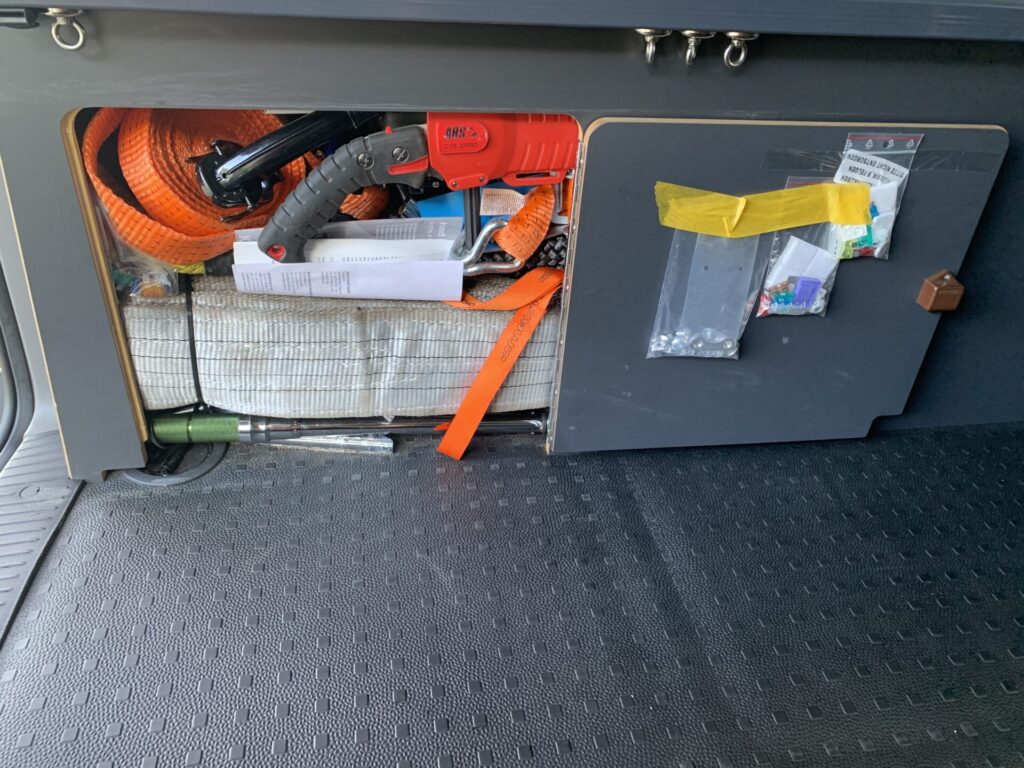
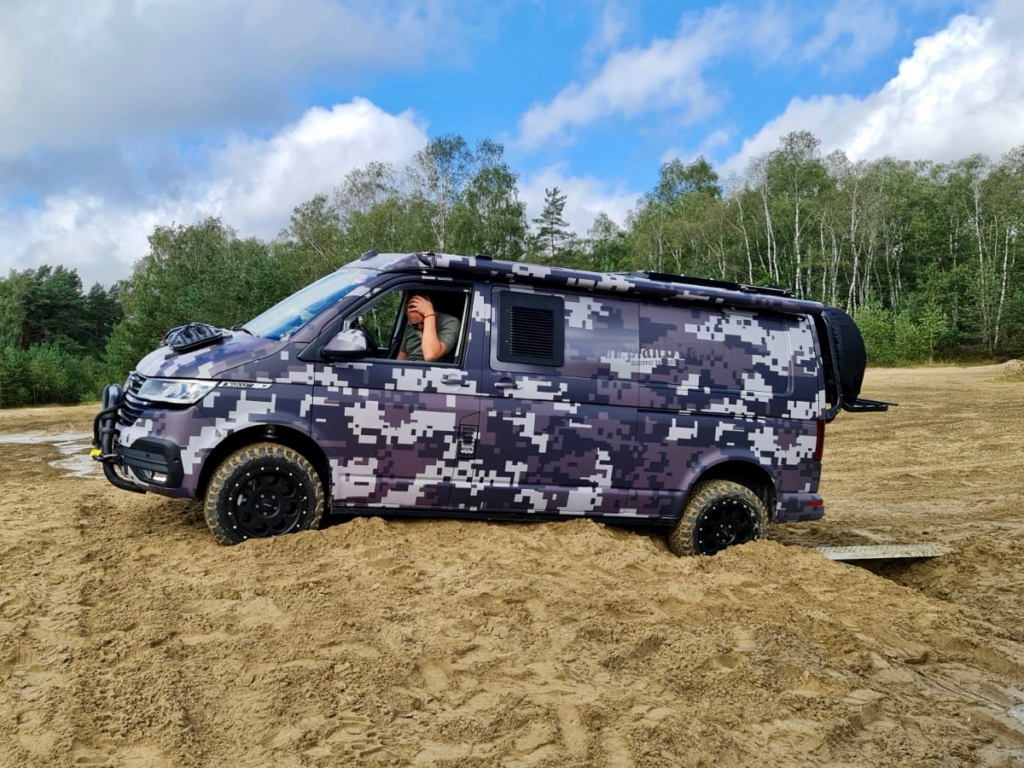
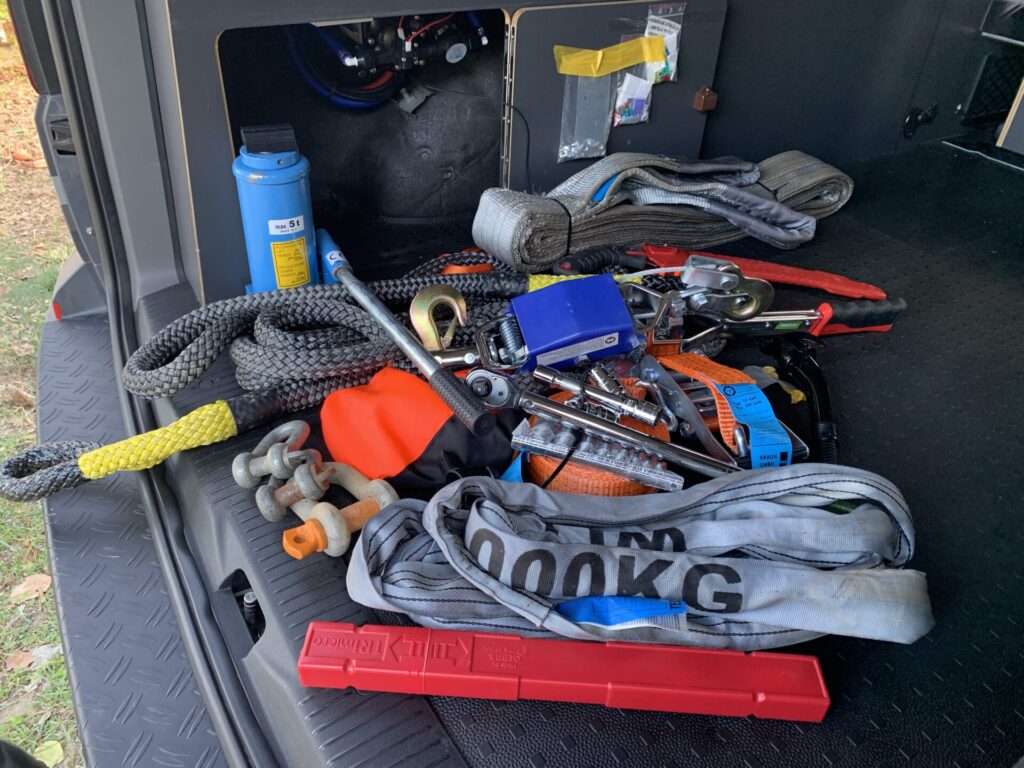
Prevention is better than cure
So that we don't even get into the situation of having to think about recovery, we have already made our BUTCH as off-road capable as possible. This includes 4Motion (that's what VW calls the 4WD version), plus hill descent assist and differential lock.
Terranger
BF Goodrich All Terrain tires and various conversions by the company Terranger, the VW off-road and travel technology specialist. Here and here these conversions are described in more detail. Conclusion here: Now goes with the VW bus much, much more than one thinks. Nevertheless, you are not immune to getting stuck deeper in the mud or sand.
Check-Up
What should be a matter of course on-road becomes mandatory off-road. Tires, engine and transmission are already under heavy strain on the road. Off-road, the strain is even greater. Pilots call it a preflight check, the inspection of the aircraft's technical condition before flight. Precisely because we don't want to take off, we should pay even closer attention.
- Is the engine warm?
- Is the oil level checked?
- Is the tire pressure correct?
- Has the traction control, also called anti-slip control, been deactivated via ASR/ESP button?
- Has the start-stop function been deactivated?
- If DSG dual clutch transmission, has this been changed to manual gear selection?
In newer vehicles such as the T6, always pay attention to these electronic helpers. On a muddy meadow, sand, and mud, a slight spinning of the wheels is not only normal, but necessary to make progress.
Otherwise, ESP would also reduce engine output if the wheels were spinning. This would cause the vehicle to slow down and, in extreme cases, come to a standstill. Certainly not desirable.
It is even less desirable that the electronics of the start-stop function then switch off the engine on top. Attention: In the newer VW models, these systems must also be turned off again after each restart.
Co-Pilot
Off the road, a simple passenger quickly becomes a co-pilot, or as in our case, a female co-pilot. The task now is to guide the driver over rough and smooth. Critical situations are often easier to foresee from the outside. From time to time it makes sense to walk the route together or individually. A radio can provide better communication.
Cable winch
Good for the one who now has a partner with a winch. But we are mostly alone on the road. And we did without a winch because of the weight. And we have been thinking about it for a while. What I liked best was the Winches-concept from Terranger. Because this has a tractive force of 7,000 kg and is designed so that the winch pulls either forward or backward. Recovery is thus possible in both directions. By being housed in the spare wheel recess, the winch is inconspicuous from the outside. But even this would not have been possible in our case. Our water tank is already accommodated in this place.
Recovery eyes | Recovery lugs | Attachment points
Nevertheless, it was worthwhile for us to deal with the subject of cable winches. Because here it quickly becomes clear that even more important than a winch, the subject vreinforced towing lugs. These are often also referred to as recovery lugs, recovery eyes or attachment points. This is because the existing towing eye is intended for the road, and is not up to the demands of off-road use. You can tell simply by the fact that with a little power you can push a car and even a bus on the road or pull it on the tow rope. Try that when the car is literally stuck in the mud.
Mountain lugs help, because these not only distribute the load over two load points, but are much more strongly connected to the structure. We deliberately provide you with two links on this topic. Relleum design (this is also where our airline rails come from) and Terranger. The former is slightly cheaper, but the latter offers an installation service. For us, the service was more important. Terranger also offers additional recovery lugs for the rear. However, these were not possible for us, because the water tank left no space for this. So we had to use the trailer hitch. This is actually only conditionally suitable for recovery and is therefore a compromise.
Shackle
We have two sizes of shackles on board so far. One is two hot-dip galvanized shackles with a working load of 6.5 tons each. And a larger shackle. This is mounted on the trailer hitch and prevents the risk of the belt slipping off when pulling diagonally upwards. This can happen quickly with a belt loop or a soft shackle.
The soft shackle in turn, on the one hand, has the advantage of saving weight. And on the other hand, they are ideal for connecting ropes or belts. When properly dimensioned, a steel shackle should deliver what it promises. But if it breaks under tension, it quickly becomes a deadly projectile. That's why we're adding soft shackles for our next tour.
Wire rope hoist
The more laborious, but by far cheaper alternative to the winch is the hand hoist. We decided to use a Kerbl cable winch after we pulled a VW Crafter motorhome out of the sand during a recovery exercise in Fursten Forest. Important: Pay attention to the 4 ton variant.
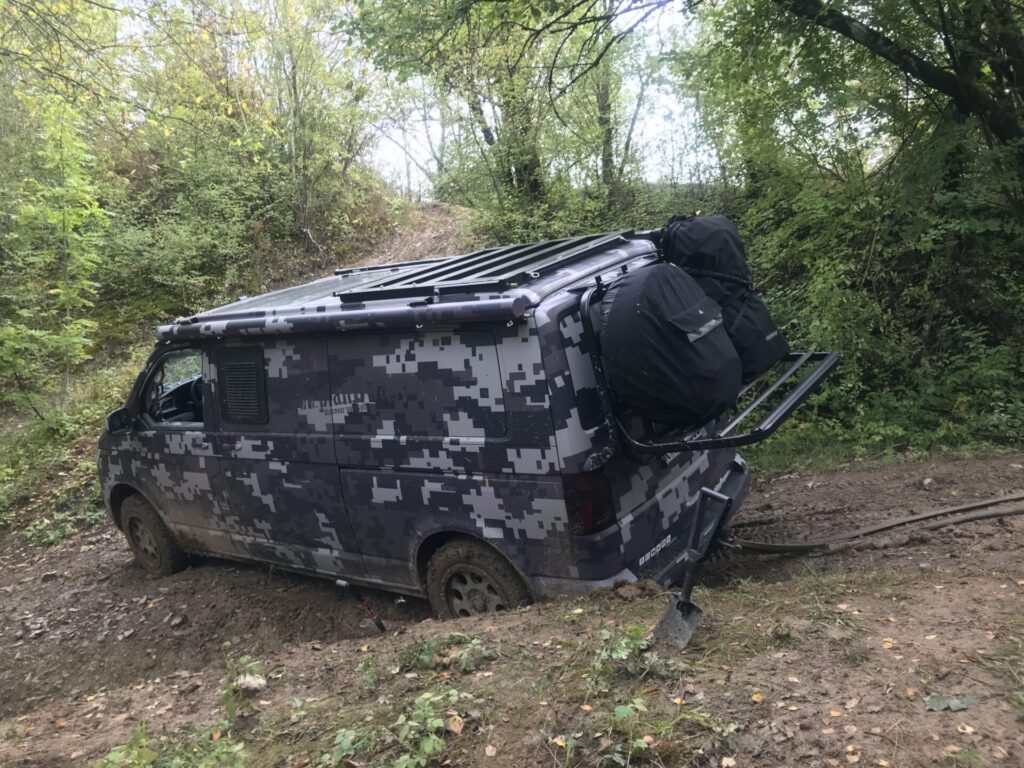

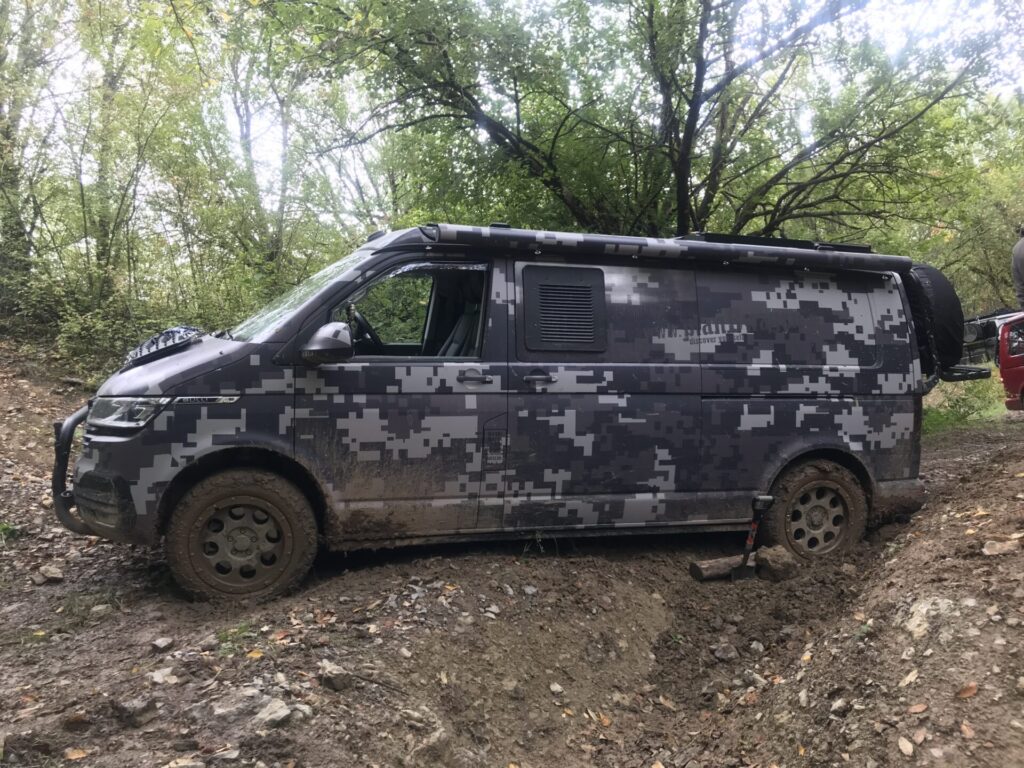
Sand plates | Shovel | Spade
If you have to recover your vehicle without the help of a winch, you should have work gloves, a shovel, or alternatively a spade, and sand plates on board. We decided to use a Fiskar folding spade. This can be used as a shovel, spade and hoe. Folded this is especially nice and small.
Likewise, sometimes branches, a thicker branch or even logs get in the way. The appropriate tool not only helps to make firewood, but can also help to avoid damage or simply get free again. Therefore, we have as well a small hatchet, also called trekking hatchet or hand axe, as well as a Swiss Gertel. This is, so to speak, the Swiss version of a machete. Our hand saw ARS CT-32PRO completes the small wood workshop. If no Globetrotter is nearby, we have also attached an Amazon link. This is then from Fiskar.
Of course, anyone who drives an off-road bulli and is a self-respecting driver has a snorkel and sand plates mounted. Oh yes, we don't have a snorkel at all. 😢 Our Air intake is placed higher, but is now invisible in the water tank. Of course, this doesn't look so good in front of the ice cream parlor.
Bergen with MAXTRAX
For this, our black MAXTRAX recovery boards, on the hood are a real eye-catcher. However, we have primarily opted for the MAXTRAX, instead of aluminum sand plates, as these should also be suitable for driving over. You have to say these things work wonders. Since we've had them, we haven't gotten stuck to the point where we needed them. Up to now a few stones were always enough. Oh yes, we had above the topic of playing in the mud. For this I recommend the video of a VW T6 driver from Australia. This one shows his recovery exercise, and the corresponding use of the Maxtrax while recovering in the mud. I'm curious to see if I'll remember to film it once the time comes.
Mountain harness | Mountain rope
In the event that the shovel and sand plates are not enough, help winches, ropes and straps. Here, safety should be the top priority. The necessary information, such as breaking load, safety factor (SF) and, above all, working load limit (WLL), can usually be seen directly on the recovery material. These values are necessary for estimating the load capacity of the harness, and thus for your own safety. Likewise, information should already be available in the description. If not, it is better to look for another supplier.
In the descriptions, however, the breaking load is often emphasized, i.e. when the recovery device, the harness or the rope breaks or tears. We certainly do not want to stress the material to such an extent, or to stress it to the breaking load. There should always be reserves for any peak loads. To minimize the risk, professionals advise that this reserve be at least 50 percent.
Safety instructions
However, in the case of good salvage material, the safety factor (SF) is also specified. This must be deducted from the breaking load. This results in the Working Load Limit (WLL), also called the nominal load capacity or maximum working load. This is the decisive value for us.
We have a three meter long recovery belt on board. This can be attached to the recovery eyes by means of shackles. This creates a belt triangle that distributes the load over the frame.
In addition, there is a 10-meter recovery belt. Both belts practically do not stretch. Thus, they are suitable for when our bus is pulled in a controlled manner or must be secured. This can occur, for example, in inclined position. The ten meter version is therefore also suitable for extension, for example, for our hand winch. This is then done with the soft shackle.
Save
There is not always a rock or tree nearby. And burying the spare wheel as an anchor may be possible, but it's also a lot of work. In order to be able to tension it to the side in case of emergency, we bought a ratchet tensioning strap. Because if it slips, it slips. We also have a round sling on board. This protects the poor tree, which must serve as an anchor.
In an inclined position, the belt should be attached as high up on the vehicle as possible. Since there are usually no anchor points here, the awning bracket can be used. Here, the safety belt should be given only a little leeway. Approx. ten to twenty centimeters. If the vehicle tilts, the distance is thus short, the jerk thus gentle. Do not worry the belt holds, but the load limit of the awning bracket is limited. To avoid unnecessary tipping movements please drive slowly. Every swing increases the load. In the end, damage to the awning would certainly be the least of your concerns. No one wants to put their vehicle on its side. And one thing I can tell you from experience by now, when a vehicle tilts it is not a good feeling. None at all! Save yourself this unnecessary salvage.
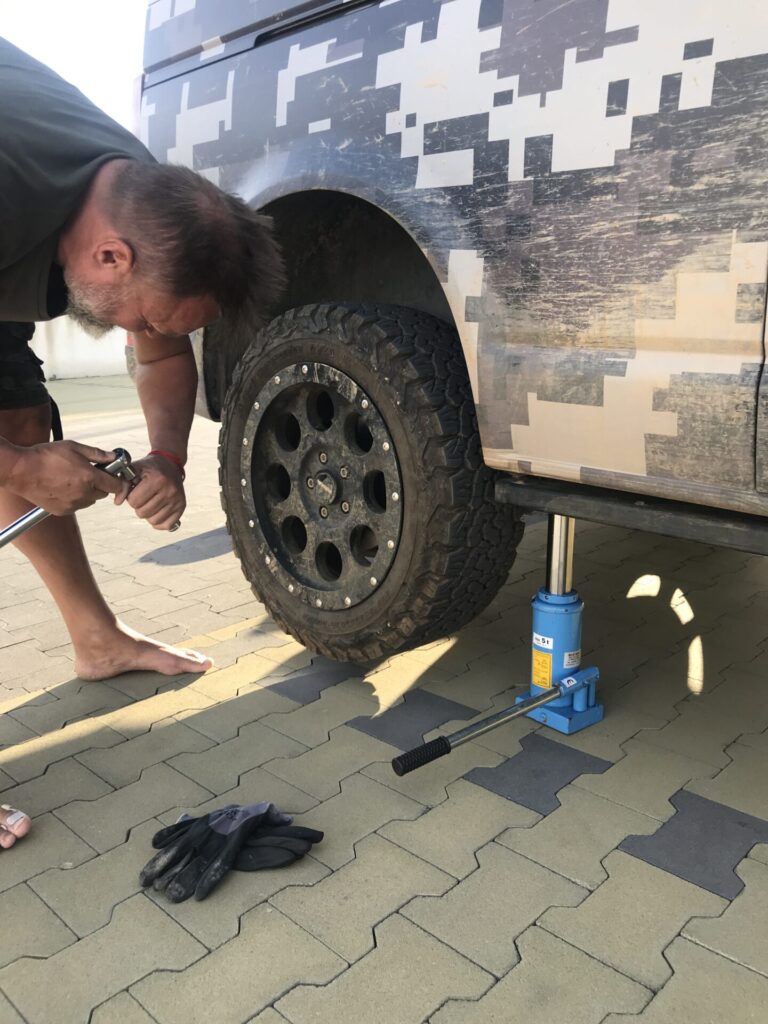
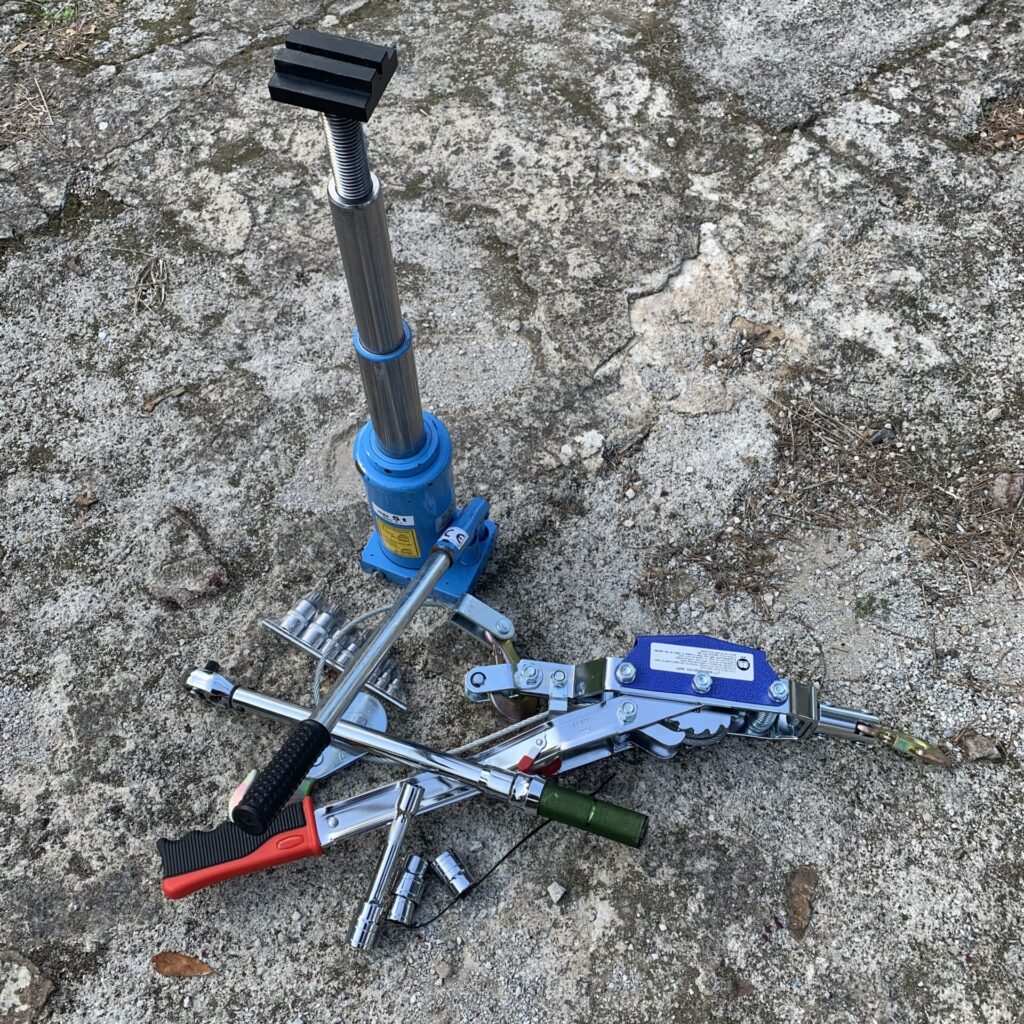
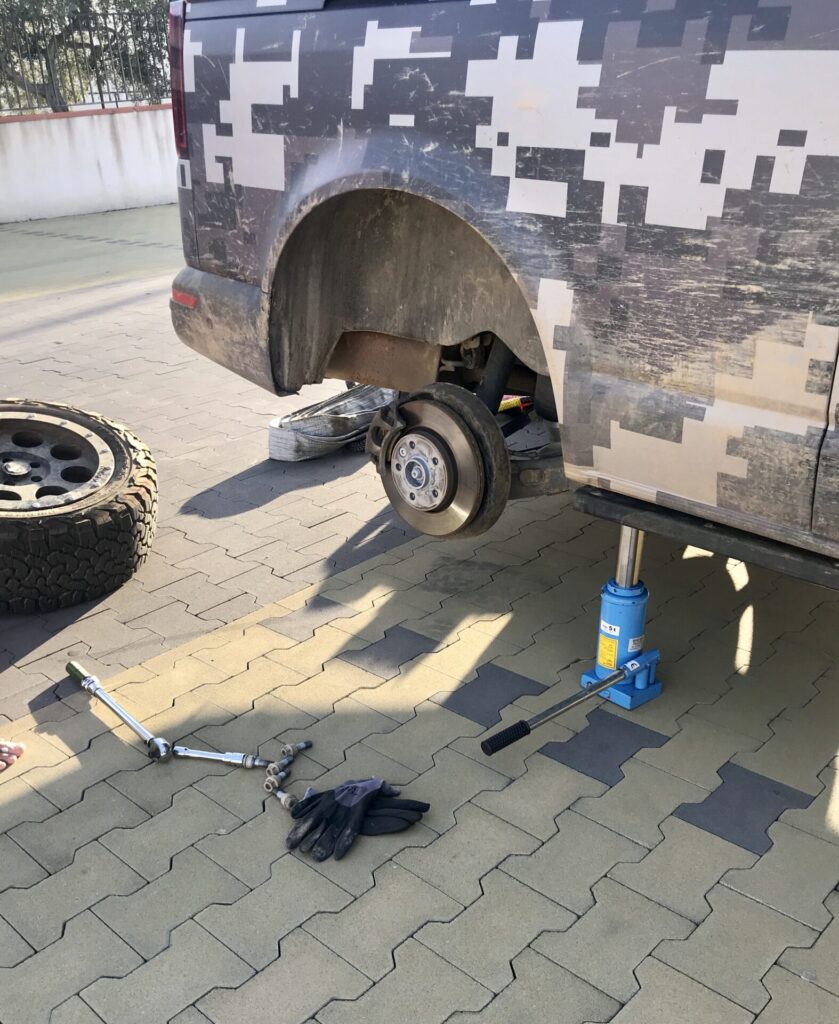
Kinetic mountain rope
A kinetic recovery rope is also part of our recovery equipment: This is ideally suited for the gentle recovery of firmly driven vehicles. Especially in solid mud or sand the first choice. Due to the high elastic properties of the rope, the force is distributed much better when starting. The jerk known from a fixed belt is reduced and the vehicles are spared.
This is especially an advantage if one of the vehicles is significantly stronger. After all, what's the point of having your frame literally plucked apart during recovery. Nevertheless, caution is also required here. It is an advantage that the towing vehicle does not have to start slowly, as is the case with the recovery belt. This allows additional force to be built up. This energy is first stored in the rope due to the stretching capacity of the material. For this very reason, it is important not to overdo it and to pull as straight as possible. This ensures that not too much energy is applied to the vehicle and that no uncontrollable swing to the side occurs.
Therefore, it is better to make two or three attempts instead of causing damage the first time. When recovering, always pull in forward gear. Reverse gear is not designed for this. And gear damage is expensive!
Offroad jack
It's a shame when the wheel change has to be done off-road. This is where two factors come together to complicate the issue. Firstly, when recovering off-road, a significantly larger stroke is often required in conjunction with a firm footing. On the other hand, a bus ready to travel already weighs considerably more than one might think. We are allowed to weigh 3.5 tons, and we do. So it was quickly clear, the standard VW jack can gladly stay at home. We put it in storage.
Instead, we have opted for a Hydraulic telescopic jack from Terranger. We have been looking for a long time, because this seemed damn sporty to us with just over three hundred euros. But what can I say, we have found nothing cheaper, and are grateful for tips. The one from Terranger packs 5 tons and has an extended total height, including spindle stroke: of 63.5 cm. A Adaption plate for the hydraulic jack, suitable for VW T5, T6 and T6.1 is also in the program. This prevents slipping from the jack mount.
If that is too expensive, we have also heard good things about the AIRJACK air jack. But be careful, if full then full. After that it is important to unplug. Otherwise there is probably only a big bang.
The Hi-Lift First Responder is of course a classic, if not a legend among jacks. Especially since it can also be used as a winch with the appropriate recovery set. But classics or not. For classics like Defender, Land Cruiser or G-Class certainly the first choice, but not suitable for the T6. The risk of denting my side is too great. It's also heavy.
Which could be an alternative is the Hydraulic ram jack from Yato. This is in any case cheaper. Whether he can also what he promises, I can not say unfortunately.
Spare wheel | tire repair set
I used to laugh when I saw someone mounting a spare wheel on the back of their bus. After waiting three days in Germany for a drive shaft on a brand new T6.1, I've stopped laughing. Delivery bottlenecks are commonplace even in Germany. How do you think this will play out only with a custom tire in Portugal, Sicily or Morocco? 😭 Our BF Goodrich All-Terrain are ready for shipment today, in Germany within two to three days. Plus postage, you can even run out of water in the mud hole. And for the day that we have to bury it then but times as an anchor, it is then also there.
Addendum: You never stop learning. After we were on our tour through the Pyrenees several times a flat tire could record, we go even a step further. From now on, a tire repair kit (Flick-Set) is on board. Did not know before that there is such a thing. Easier than to patch the tire on our folding roof. However, if the sidewall is destroyed, even this does not help. Therefore, we will throw on the next expedition in addition to an AT tire, that is, only the jacket with the roof. You can get that mounted in almost any workshop.
Battery
Electricity is and remains a hot topic among campers. If the starter battery is empty, you need a jump start. Powerbanks for on the road, so-called tragable car battery booster, with Jumper cables and jumper cables.
These must be designed for diesel engines only. Ours from DB Power is no longer on sale. But we have found a variant from NOCO. This is designed for gasoline engines up to 6-liter and 3-liter diesel engines.
Compressor
If you want to deflate off-road, you should have a compressor on board. Because what may make sense on sand or mud is no good on the road. That's why the air has to go back in. We use the VIAIR 300P. With 65 liters of capacity, a compact, yet very powerful compressor from the market leader Viair.
Board & Special Tools
Something does break from time to time. In our case, it was one of the rear drive shafts. This, of course, in the middle of the terrain. So that we could be salvaged at all, this had to be removed first. Thank God I was with the right guys. I never thought how fast something like this can be done if you have the right tools. Because VW likes to use multi-tooth. In the meantime, the corresponding set of keys Internal multipoint tooth on board.
Otherwise, we have common tools on board. Because there is not only at the Bulli, but also from time to time what to screw, hammer... Surely everyone will put together his tools individually. We have partly inexpensive building market tools with us. The 56-piece Wisent tool bag comes, for example, from BAUHAUS. Our Zyklop hybrid ratchet set and the Open-end wrench I have, however Wera purchased. Very good tool and you do not treat yourself to anything else.
What you must not forget in any case are Armor tape, WD40 and cable ties. Needed again and again! Also Aluminum heat protection tape can't hurt if a hose ever needs to be sealed. A magnet, Telescope tool set and OBD2 diagnostic device certainly require some screwdriver experience. The small Tool roll is from the company Kriega.
Fuses
What fits the theme of security, clearly fuses. Sometimes it's the little things that break on the road. A defective bulb is one issue. But a fuse can disable a lot of things on the road. That's why your tools should not only include the appropriate set of bulbs, but also a selection of fuses. What we only thought of at the end was that our VB Airsuspension also has its own fuses.
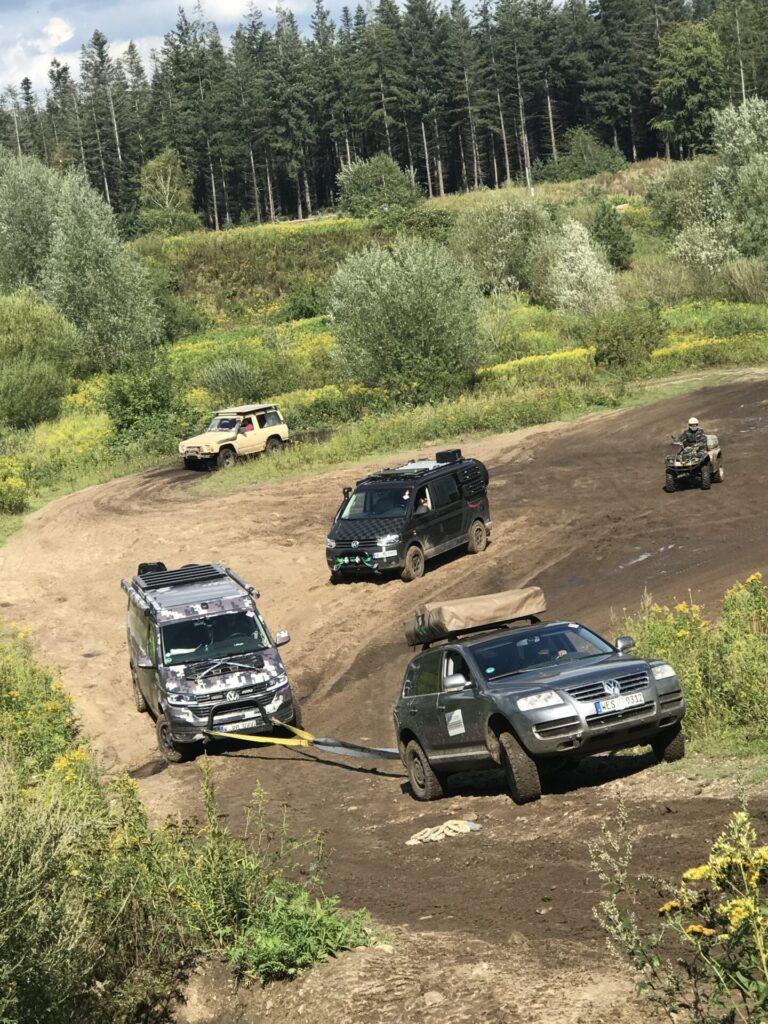
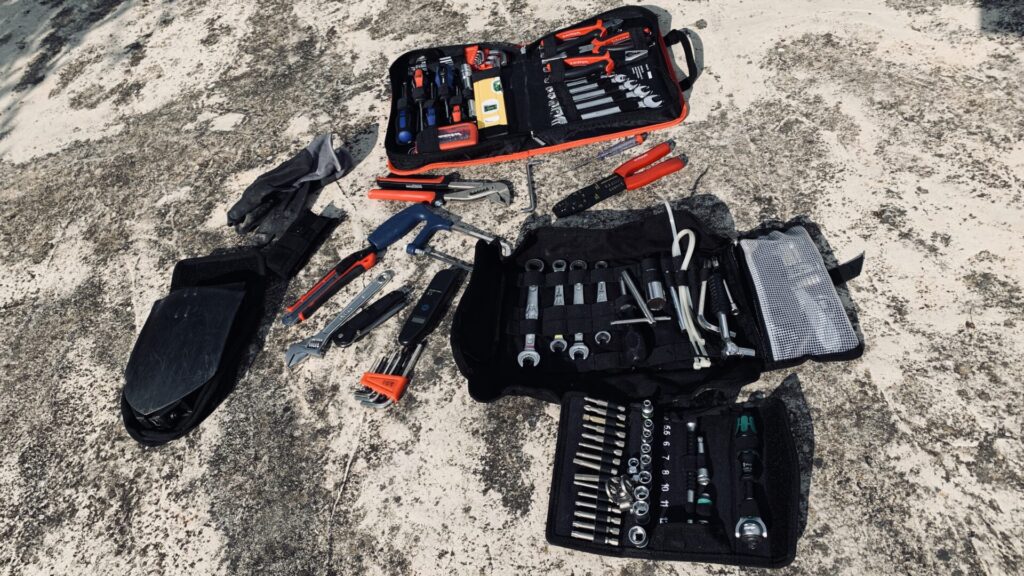
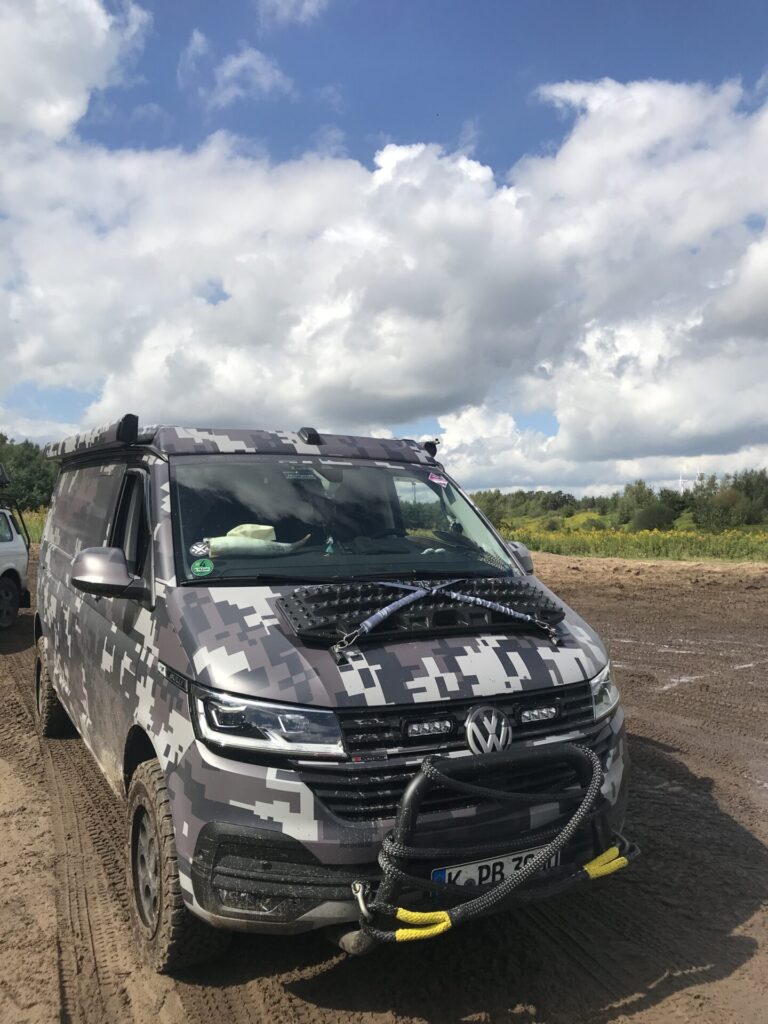
Note: Our packing list contains our personal product recommendations with so-called affiliate links. Don't worry: Nothing will change for you. The products will not become more expensive. If you buy something through one of these links, we get a small commission. It doesn't matter if you buy exactly the linked item or something else. In the year 2020 we have earned € 29,87 by doing this 
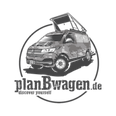
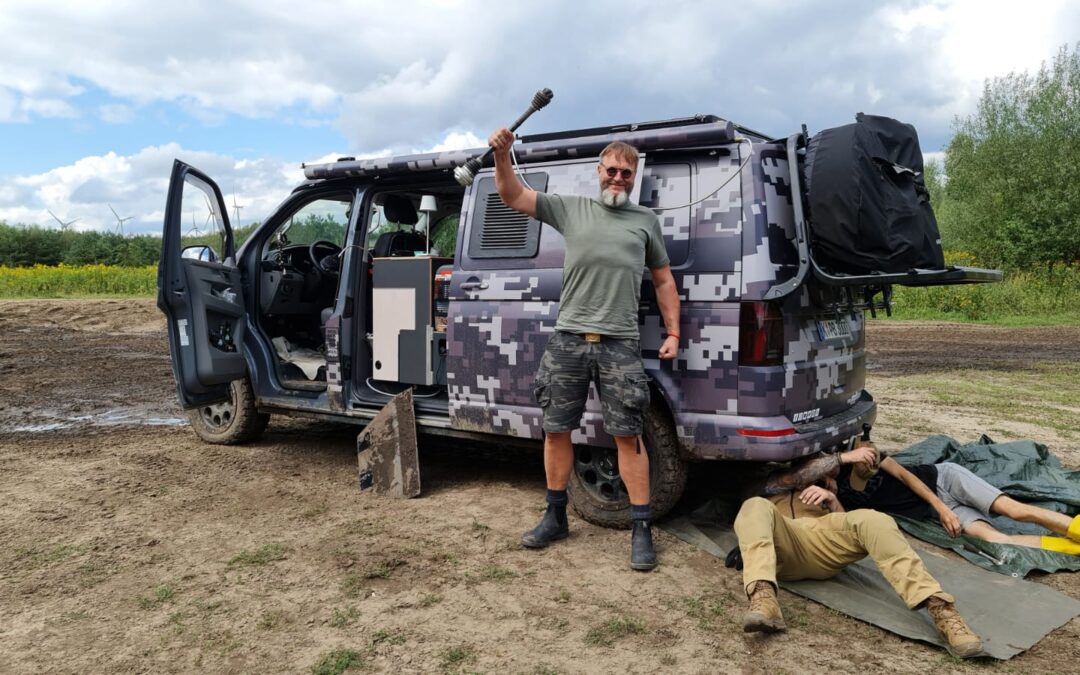
Recent Comments